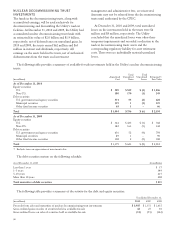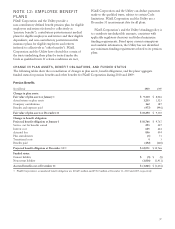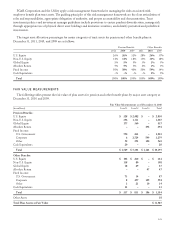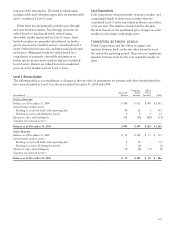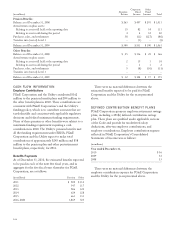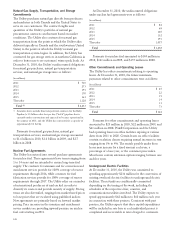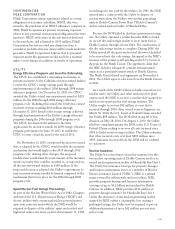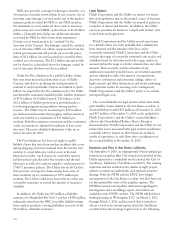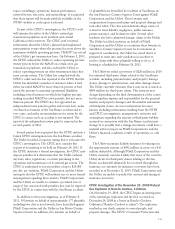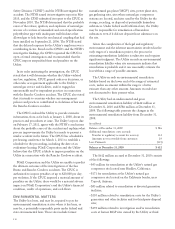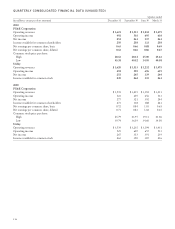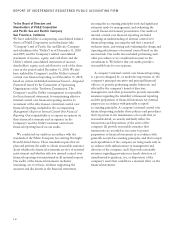PG&E 2010 Annual Report Download - page 110
Download and view the complete annual report
Please find page 110 of the 2010 PG&E annual report below. You can navigate through the pages in the report by either clicking on the pages listed below, or by using the keyword search tool below to find specific information within the annual report.
The Utility’s significant related party transactions were
as follows:
Year Ended December 31,
(in millions) 2010 2009 2008
Utility revenues from:
Administrative services provided
to PG&E Corporation $7 $5 $ 4
Utility expenses from:
Administrative services received
from PG&E Corporation $55 $ 62 $ 122
Utility employee benefit due to PG&E
Corporation 27 32
At December 31, 2010 and December 31, 2009, the
Utility had a receivable of $89 million and $26 million,
respectively, from PG&E Corporation included in accounts
receivable – other and other noncurrent assets – other on
the Utility’s Consolidated Balance Sheets, and a payable of
$16 million, respectively, to PG&E Corporation included
in accounts payable – other on the Utility’s Consolidated
Balance Sheets.
NOTE 15: COMMITMENTS AND
CONTINGENCIES
PG&E Corporation and the Utility have substantial
financial commitments in connection with agreements
entered into to support the Utility’s operating activities.
PG&E Corporation and the Utility also have significant
contingencies arising from their operations, including
contingencies related to guarantees, regulatory proceedings,
nuclear operations, environmental compliance and
remediation, tax matters, and legal matters.
COMMITMENTS
UTILITY
Third-Party PowerPurchase Agreements
As part of the ordinary course of business, the Utility
enters into various agreements to purchase power and
electric capacity. The price of purchased power may be
fixed or variable. Variable pricing is generally based on the
current market price of either gas or electricity at the date
of purchase.
The table below shows the costs incurred for each type
of third-party power purchase agreement at December 31,
2010:
Payments
(in millions) 2010 2009 2008
Qualifying facilities (1 )(2) $ 1,164 $ 1,210 $ 1,724
Renewable energy contracts (1) 573 362 302
Other power purchase
agreements (1) 598 643 2,036
Irrigation district and water
agencies (1) 59 58 69
(1) The amounts above do not include payments related to DWR
purchases for the benefit of the Utility’s customers, as the Utility only
acts as an agent for the DWR.
(2) Payments include $321, $344, and $412 attributable to renewable
energy contracts with qualifying facilities at December 31, 2010, 2009
and 2008, respectively.
Qualifying Facility PowerPurchase Agreements – Under the
Public Utility Regulatory Policies Act of 1978 (“PURPA”),
electric utilities are required to purchase energy and
capacity from independent power producers with
generation facilities that meet the statutory definition of a
qualifying facility (“QF”). QFs include small power
production facilities whose primary energy sources are
co-generation facilities that produce combined heat and
power (“CHP”) and renewable generation facilities. To
implement the purchase requirements of PURPA, the
CPUC required California investor-owned electric utilities
to enter into long-term power purchase agreements with
QFs and approved the applicable terms and conditions,
prices, and eligibility requirements. These agreements
require the Utility to pay for energy and capacity. Energy
payments are based on the QF’s actual electrical output
and CPUC-approved energy prices, while capacity
payments are based on the QF’s total available capacity and
contractual capacity commitment. Capacity payments may
be adjusted if the QF exceeds or fails to meet performance
requirements specified in the applicable power purchase
agreement.
As of December 31, 2010, the Utility had agreements
with 226 QFs for approximately 3,700 megawatts (“MW”)
that are in operation. Agreements for approximately 3,400
MW expire at various dates between 2011 and 2028. QF
power purchase agreements for approximately 300 MW
have no specific expiration dates and will terminate only
when the owner of the QF exercises its termination option.
The Utility also has power purchase agreements with 75
inoperative QFs. The total of approximately 3,700 MW
consists of approximately 2,500 MW from cogeneration
projects and approximately 1,200 MW from renewable
sources. No single QF accounted for more than 5% of the
Utility’s 2010, 2009, or 2008 electricity sources.
Renewable Energy PowerPurchase Agreements — The Utility
has entered into various contracts to purchase renewable
energy to help the Utility meet the current renewable
portfolio standard (“RPS”) requirement. In general,
renewable contract payments consist primarily of per
megawatt hour (“MWh”) payments and either a small or
no fixed capacity payment, as opposed to contracts with
non-renewable sources, which generally include both a per
MWh payment and a fixed capacity payment. As shown in
the table below, the Utility’s commitments for energy
106


